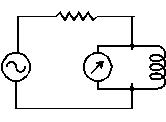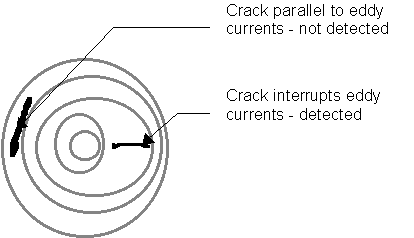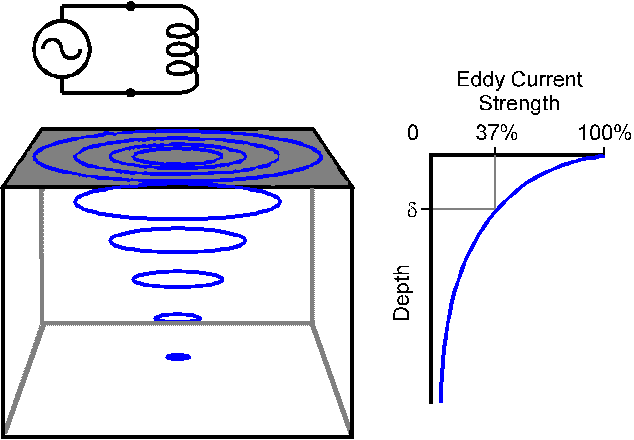
Basic Eddy Current Testing, Pt 1
When an AC current flows in a coil in close proximity to a conducting surface the magnetic field of the coil will induce circulating (eddy) currents in that surface. The magnitude and phase of the eddy currents will affect the loading on the coil and thus its impedance.

As an example, assume that there is a deep crack in the surface immediately underneath the coil. This will interrupt or reduce the eddy current flow, thus decreasing the loading on the coil and increasing its effective impedance.

This is the basis of eddy current testing, by monitoring the voltage across the coil in such an arrangement we can detect changes in the material of interest.

Note that cracks must interrupt the surface eddy current flow to be detected. Cracks lying parallel to the current path will not cause any significant interruption and may not be detected

A number of factors, apart from flaws, will affect the eddy current response from a probe. Successful assessment of flaws or any of these factors relies on holding the others constant, or somehow eliminating their effect on the results. It is this elimination of undesired response that forms the basis of much of the technology of Eddy current inspection. The main factors are:
Material conductivity
The conductivity of a material has a very direct effect on the eddy current flow: the greater the conductivity of a material the greater the flow of eddy currents on the surface. Conductivity if often measured by an eddy current technique, and inferences can then be drawn about the different factors affecting conductivity, such as material composition, heat treatment, work hardening etc.
Permeability
This may be described as the ease with which a material can be magnetised. For non-ferrous metals such as copper, brass, aluminium etc., and for austenitic stainless steels the permeability is the same as that of 'free space', i.e. the relative permeability(mr) is one. For ferrous metals however the value of mr may be several hundred, and this has a very significant influence on the eddy current response, in addition it is not uncommon for the permeability to vary greatly within a metal part due to localised stresses, heating effects etc.
Frequency
As we will discuss, eddy current response is greatly affected by the test frequency chosen, fortunately this is one property we can control.
Geometry
In a real part, for example one which is not flat or of infinite size, Geometrical features such as curvature, edges, grooves etc. will exist and will effect the eddy current response. Test techniques must recognise this, for example in testing an edge for cracks the probe will normally be moved along parallel to the edge so that small changes may be easily seen. Where the material thickness is less than the effective depth of penetration (see below) this will also effect the eddy current response.
Proximity / Lift-off
The closer a probe coil is to the surface the greater will be the effect on that coil. This has two main effects:
The "lift-off" signal as the probe is moved on and off the surface.
A reduction in sensitivity as the coil to product spacing increases.

The eddy current density, and thus the strength of the response from a flaw, is greatest on the surface of the metal being tested and declines with depth. It is mathematically convenient to define the "standard depth of penetration" where the eddy current is 1/e (37%) of its surface value.
The standard depth of penetration in mm is given by the formula:

where rho is resistivity in microohm.cm and f is frequency in Hz
from this it can be seen that depth of penetration:

The graph above shows the effect of frequency on standard depth of penetration .
It is also common to talk about the "effective depth of penetration" usually defined as three times the standard depth, where eddy current density has fallen to around 3% of its surface value. This is the depth at which there is considered to be no influence on the eddy current field.
Back to the Start · Previous Page · Next Page